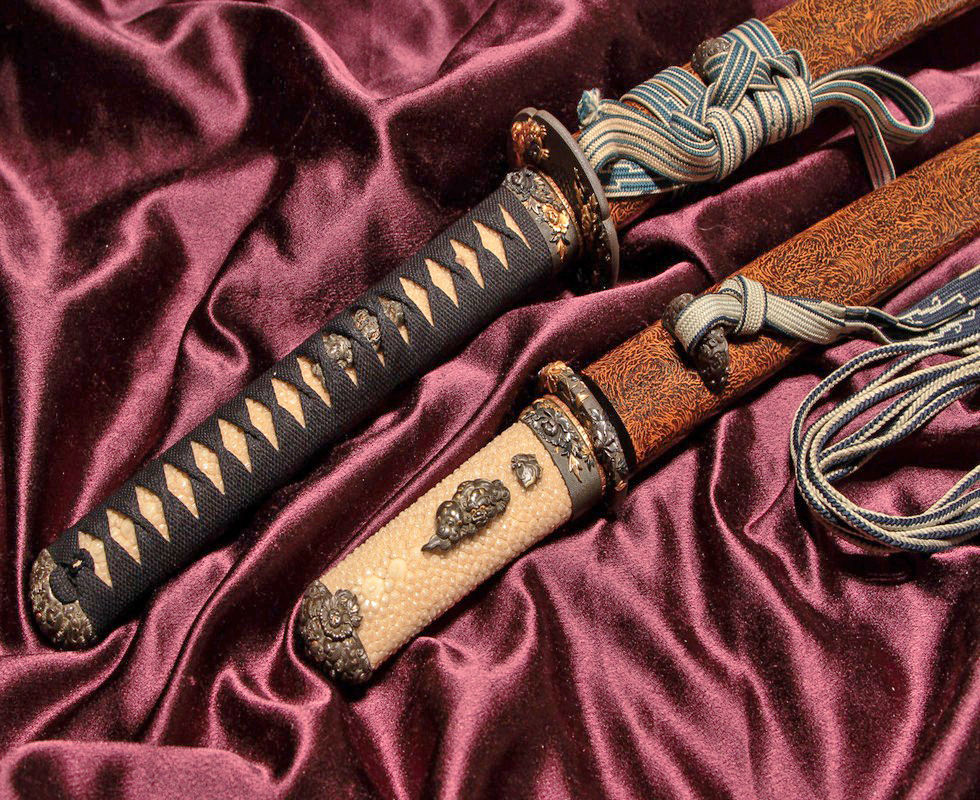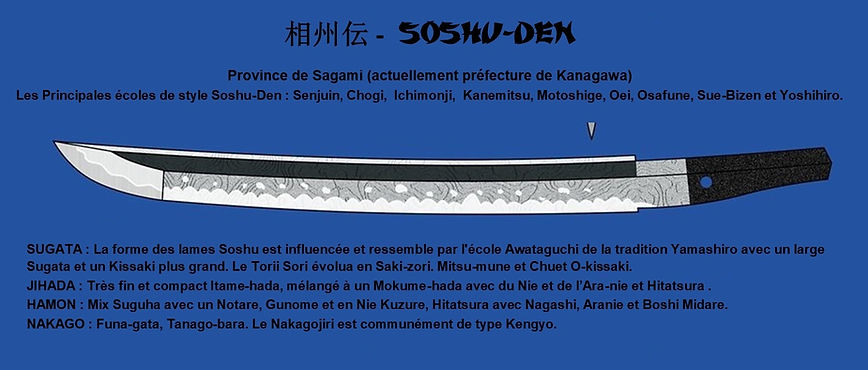
_d04a07d8- 9cd1-3239-9149-20813d6c673b_THE MAIN STYLES OF KOTO FORGE
Here is a brief overview of the five major blacksmithing traditions of the Koto period. These are Yamashiro-Den, Yamato-Den, Bizen-Den, Mino-Den and Soshu-Den style.
YAMASHIRO-DEN
SUGATA:The Yamashiro-style Sugata (late Heian to early Kamakura era) was narrow and graceful. The blades had a wide Mihaba that tapered into Ko-kissaki (this is called Funbari).
During the mid to late Kamakura period, the Sugata changed from thin to broad. The Kissaki became bigger and sturdier (Ikubi Kissaki) and the Funbari (blade narrowing) decreased so that even at Yokote the blade was wide. This was when the Bizen Den was at its height and greatly influenced these changes in the Yamashiro-style Sugata.
From the Nanbokucho period to the Muromachi period, the Yamashiro style gradually disappeared, but it continued to influence several schools of blacksmithing in the Shinto era.
JIHADA:The most common is Ko-mokume, usually in a much finer grain pattern than other schools. It contains Chikei and Ji-nie. Often early schools such as that of Awataguchi will have a beautiful Utsuri and the blades will be very close in appearance to those of the Ko-Bizen school. From the middle to late Kamakura period, the Jihada becomes Chu-mokume or O-mokume, rather than Ko-mokume hada.
HAMON:During the Kamakura era, there are two types of Hamon found on Yamashiro blades. The first was a Suguha-based Ko-choji Midare mixed with Ko-nie, displaying splendid activity. The second type was a wide Suguha Choji-midare based on a Suguha with Ashi and Nie. This type of Hamon is found in the Rai school and was influenced by the Bizen style.
For the middle Hamon, at the end of the Kamakura era, we find a base of Suguha mixed with a small amount of O-Midare, with good activity inside the Hamon. There are also Midare Kyo-choji. They are Choji Midare based on Suguha and whose Yakigashira (top of the Midare) is inclined to be flat.
NAKAGO:Long and tapered. The Jiri (end of the Nakago) of the blades forged 700 years ago (the oldest) were Kuri type. Those forged after this period tend to be Kuri and Kengyo type.
YAMATO-DEN
SUGATA:The development of sword-making in the Yamato region of Japan was closely linked to the region's proximity to the capital Nara. Moreover, the prosperity of the blacksmiths depended on their relationship with the temples to which they were affiliated.
In the late Heian era and early Kamakura era, the shape of Yamato style blades was narrow and graceful. They were thicker than the Yamashiro type with a much higher Shinogi. By the end of the Kamakura era, the five schools of Yamato blade forges had mostly disappeared (except for the Hosho school), and Yamato blades from the Nanbokucho era are very rare.
The Yamato tradition, however, exerted a great influence on many other schools such as Shizu, Akasaka Senjuin, Ino, Uda, Asako, Iruka, Sudo, Mihara, Kanabo and others.
JIHADA:The Yamato-style Jihada (mid-Kamakura era) will be larger than the late Yamashiro-style Jihada of the same era. It will consist of Masame-hada, but when the Jihada is Mokume type, it tends to be Nagare-hada combined with Masame-hada of some finesse. There will always be Masame-hada in Shinoji-ji. The Taima school will have a beautiful well-forged Mokume-hada mixed with an Itame-hada with Chikei and Yubashiri appearing. Only the Hosho school will always have pure Masame-hada with abundant Ji-nie.
HAMON:The Hamon is a base of Suguha in Nie-deki, as it is in the Yamashiro tradition, but with vertical activities such as Nijuba, Uchinoke and Hakikake appearing along the Hamon. The Nie is more prominent than in the Yamashiro tradition and more luminous. The amount of Nie on a blade varies between abundant or rare. Occasionally and especially in the Senjuin school, Suguha Hotsure will be mixed with Ko-choji and Ko-midare. As with the other schools, there will be Nijuba, Uchinoke, Kuichigaiba, Kinsuji and Hakikake.
NAKAGO:The Nakagojiri varies somewhat between schools. The Taima and Shikkake schools have an Iri-yamagata type Nakagojiri, the others have a Kuri type Nakagojiri. The Yasurime are of the Takanoha, Higaki, Kiri or Katte-sagari types depending on the school.
BIZEN-DEN
SUGATA:The blades are graceful with Koshi-zori (the curve of the Sori is concentrated in the lower third of the blade) is considered a feature of Bizen Den blades. A very pronounced Koshi-zori is found on many Ko-Bizen blades, from the late Heian eras and the beginning of the Kamakura period resembling the blades of the Yamashiro tradition of the same period.
In the middle and late Kamakura era, the brilliant tradition of Bizen was established by the Ichimonji and Osafune schools. The Sugata becomes larger than those of previous periods and we start to see blades with a big and strong Ikubi Kissaki. One can observe a less pronounced Sugata like on the older blades and resembling the Yamashiro Den blades.
The Nanbokucho era brings oversized Sugata where we find blades reaching a length of up to 91cm and with very large Kissaki. During the Muromachi era, the length of the blade becomes shorter and the Sori is moved across the blade creating a Saki-zori. We see the birth of the Uchi-katana, a short sword barely 60 cm long that could be wielded with one hand. The Bizen style continued well into the Shinto and Shinshinto eras.
JIHADA:Mainly composed of a combination of Itame-hada and Mokume-hada. We find Ko-mokume, Chu-mokume and O-mokume which are generally combined with Itame-hada. A Utsuri in different forms is frequently seen in the Ji.
HAMON:Mainly in Midareba and Nioi-deki. There are many forms of Choji-midare and Gunome-midare. The mighty Juka-choji of the Fukuoka Ichimonji school (of the Kamakura era) is considered by many to be the finest work of the Bizen style which was then at its height. There are also Suguha, especially in the Muromachi period and later. The Nie is medium in size and abundant along the Nioi line, and it is rarely found in the form of Ji-nie.
NAKAGO:Older Nakagos tend to be long and lean, with a Hira (rounded) Niku and they are well proportioned. Over time they gradually became thick and short with parallel sides and after Oei, (1394-1428) there were many which were so short that at first glance they appeared unbalanced. These are called Uchi-gatana and usually used with one hand. Nakago-jiri is generally of the Kuri type.
MINO-DEN
SUGATA:In the early Mino period, the Sugata was roughly standard compared to what was done towards the end of the Kamakura era. The Mihaba was not very wide and the Kissaki was at most a Chu-kissaki.
From the middle of the Nanbokucho era to the beginning of the Muromachi era, the Mihaba became wider and the Kissaki taller. Tantos are rare. Hira-zukuri Ko-wakizashi with a wide Mihaba and Sori are popular.
During the later Mino period (The Sue-seki school), two Sugata of Katana were developed. One with a wider than usual Shinogi-ji, despite his relatively narrow Mihaba. The other with a wider Mihaba, a narrower Shinogi-ji and with a deep Saki-zori. Often we find Shobu-zukuri Tanto, Yari and Naginata. There are three general sizes of Tanto, around 20cm, 26cm, and over 30cm.
JIHADA:During the early Mino period, we find O-mokume Hada combined with Masame-hada with abundant Chikei and Ji-nie. The Jihada is clear and does not appear whitish. In the middle of the Mino period, we find a Mokume-hada combined with a Masame-hada which stands out near the Hamon in the Shinogi-ji. The Jigane looks a little whitish and powerful.
During the last Mino period the blades will have a powerful Jigane. The Jigane will be dark, almost blackish. The Ji will be a coarse Mokume-hada and the Hada in the Shinogi-ji will be a Masame.
HAMON:During the first period we find blades forged in Nie-deki, with abundant Nie and thick Nioi. Both Nie and Nioi are bright and large Nie will sometimes be found. Widths vary considerably. The Hamon are O-midare, O-gunome midare, Notare-midare, etc. types, along with Kuzure, Inazuma, Sunagashi and Kinsuji.
In the middle period, the Hamon will be wide in O-midare or Gunome-midare, with Nie. The Hamon has a deformed zone which produces Togari-ba and Sunagashi.
During the last period we find Togari Gunome with three peaks at regular intervals. This is the famous Sanbon-sugi (three cypress trees) for which the Mino school is famous. Other Hamon motifs such as O-notare, Yahazu-midare, Hitatsura, etc. can be found. Sometimes you can also find Suguha from time to time. Note however that in all Hamon of the Mino den style, there will always be at least one small pointed Midare (Togari). This is even true for the Suguha (right).
NAKAGO:The Nakago of the first period will be in Kuri-jiri and on the Tanto, we sometimes see in Furisade with a deep Sori. Yasurime are shallow Kiri or Katte-sagari types. Middle-period Yasurime may be Kiri, Katte-sagari, or sometimes Higaki-type. During the later Mino period, the Kurijiri type is very popular, and Yasurime are usually Higaki or Takanoha types.
SOSHU-DEN
SUGATA:The Soshu-Den style was founded in the city of Kamakura and was the last of the five major Koto schools to appear. The Soshu-Den was founded at the end of the 13th century by Shintogo Kunimitsu who has his roots in the Awataguchi school of the Yamashiro tradition.
Thus, early Soshu-style blades from the late Kamakura era and early Nanbokucho era show influence from the Yamashiro tradition of the same era. The Sugata tended to be wide and often featured a taller Kissaki. Generally, during the early period and mid-Soshu period, the blades had a Torii Sori type Sori which transformed in the Muromachi era into Saki-zori.
JIHADA:The Hada is most often a very thin and compact Itame-hada, mixed with a Mokume-hada. Sometimes it will be combined with O-hada. It has abundant Nie and Ara-nie throughout the Ji. It will often take the form of a Hitatsura (full temper), especially during the middle of the Soshu blade-making period (Nanbokucho era).
HAMON:The Hamon will come in various forms. The first Soshu blades are strongly influenced by the Yamashiro style and therefore we find a beautiful Mokume-hada with an abundant Ji-nie and a rounded Yubashiri. Others will be large and based on a Suguha, but mixed with a Notare and Nie Kuzure. It will often take the form of a Titatsura (full temper), especially in the middle of the middle Soshu blade-making period (Nanbokucho era).
NAKAGO:Probably the most common form of Nakago is Funa-gata. Another typical form is called Tanago-bara. (It looks like the abdomen of the Tanago fish found in the rivers of Soshu province). The Nakagojiri is commonly Kengyo type.
.jpg)




GOKADEN OR THE 5 FORGE TRADITIONS OF THE KOTO PERIOD



